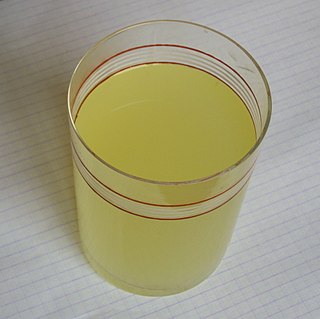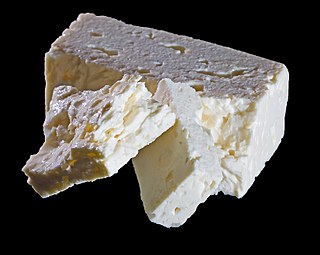Related Research Articles

Mozzarella is a semi-soft non-aged cheese prepared by the pasta filata method with origins from southern Italy.

Pizza cheese encompasses several varieties and types of cheeses and dairy products that are designed and manufactured for use specifically on pizza. These include processed and modified cheese, such as mozzarella-like processed cheeses and mozzarella variants. The term can also refer to any type of cheese suitable for use on pizza. The most popular cheeses used in the preparation of pizza are mozzarella, provolone, cheddar and Parmesan. Emmental, pecorino romano and ricotta are often used as toppings, and processed pizza cheeses manufactured specifically for pizza are mass-produced. Some mass-produced pizza cheeses are frozen after manufacturing and shipped frozen.

Rennet is a complex set of enzymes produced in the stomachs of ruminant mammals. Chymosin, its key component, is a protease enzyme that curdles the casein in milk. In addition to chymosin, rennet contains other enzymes, such as pepsin and a lipase.

Halloumi or haloumi is a cheese of Cypriot origin made from a mixture of goat's and sheep's milk, and sometimes also cow's milk. Its texture is described as squeaky. It has a high melting point and so can easily be fried or grilled, a property that makes it a popular meat substitute. Rennet is used to curdle the milk in halloumi production, although no acid-producing bacteria are used in its preparation.

Whey is the liquid remaining after milk has been curdled and strained. It is a byproduct of the manufacturing of cheese or casein and has several commercial uses. Sweet whey is a byproduct resulting from the manufacture of rennet types of hard cheese, like cheddar or Swiss cheese. Acid whey is a byproduct brought out during the making of acid types of dairy products, such as strained yogurt.

Cottage cheese is a curdled milk product with a mild flavor and a creamy, heterogeneous, soupy texture. It is made from skimmed milk by draining curds but retaining some of the whey and keeping the curds loose. An essential step in the manufacturing process distinguishing cottage cheese from other fresh cheeses is the addition of a "dressing" to the curd grains, usually cream, which is mainly responsible for the taste of the product. Cottage cheese is not aged.

Feta is a Greek brined white cheese made from sheep's milk or from a mixture of sheep and goat's milk. It is soft, with small or no holes, a compact touch, few cuts, and no skin. Crumbly with a slightly grainy texture, it is formed into large blocks and aged in brine. Its flavor is tangy and salty, ranging from mild to sharp. Feta is used as a table cheese, in salads such as Greek salad, and in pastries, notably the phyllo-based Greek dishes spanakopita "spinach pie" and tyropita "cheese pie". It is often served with olive oil or olives, and sprinkled with aromatic herbs such as oregano. It can also be served cooked, as part of a sandwich, in omelettes, and many other dishes.

Paneer, also known as ponir, is a fresh acid-set cheese common in the cuisine of the Indian subcontinent made from full-fat buffalo milk or cow milk. It is a non-aged, non-melting soft cheese made by curdling milk with a fruit- or vegetable-derived acid, such as lemon juice.

Bundz - also known as bunc(Podhale dialect) and budz is Polish and Ukrainian and Goral sheep milk cheese. It is traditionally produced in Polish mountains - Bieszczady, in Podhale and Ukraine.

Cheese is a dairy product produced in a range of flavors, textures, and forms by coagulation of the milk protein casein. It comprises proteins and fat from milk. During production, milk is usually acidified and either the enzymes of rennet or bacterial enzymes with similar activity are added to cause the casein to coagulate. The solid curds are then separated from the liquid whey and pressed into finished cheese. Some cheeses have aromatic molds on the rind, the outer layer, or throughout.

Oltermanni is a brand of Finnish cheese somewhat similar to the Danish cheese Havarti. It is often eaten on rye bread, or with other dishes. Oltermanni is manufactured by Valio. The cheese is less salty than others.

Koryciński, also known as "Swojski" (homemade), is a hard cheese made from cow's milk, named after the village of Korycin in Poland, and made in the Podlaskie Voivodeship in eastern Poland. In the traditional technique of producing the cheese, dried and powderized veal stomachs were used as rennet. The cheese takes the form of a flattened ball with a diameter of 30 cm and weight of 3 kg. Normally, around 25 litres of milk are used to produce it. It is considered to be the oldest Polish cheese. Currently, different varieties of the cheese are produced, most notably the ones with herbs and garlic added as ingredients.

Beecher's Handmade Cheese is an artisan cheesemaker with retail locations in the greater Seattle area and several airports. The company was founded by Kurt Beecher Dammeier in 2003 and opened in Pike Place Market after Dammeier obtained a difficult to obtain storefront lease in the Market. Because Dammeier had never been a cheesemaker, he sought out the assistance of Brad Sinko, who helped run a family cheese-making business in Oregon. A second location was opened in 2011 Manhattan's Flatiron District; this closed in October, 2022.
Samsø is a Danish cow's milk cheese named after the island of Samsø located in Denmark. It was invented in the later 19th century (1870s) when the king of Denmark invited Swiss cheesemakers to teach their skill. It is similar to Emmentaler, although its flavour is milder: gentle and nutty in young cheeses and pungent with sweet and sour notes in older ones. Samsø's interior has a supple, elastic texture; a yellow colour; and a few large, irregular holes. The cheese has goldenrod coloured rind covered with a yellow wax.

Chhena or chhana is a kind of cheese originating from the Indian subcontinent that is made from water buffalo or cow milk by adding food acids such as lemon juice and calcium lactate instead of rennet and straining the whey through filtration.

Sheep milk cheese is a cheese prepared from sheep milk. Well-known cheeses made from sheep milk include the feta of Greece, Roquefort of France, manchego from Spain, the pecorino romano and ricotta of Italy. Yogurts, especially some forms of strained yogurt, may also be made from sheep milk.

Sour cream is a dairy product obtained by fermenting regular cream with certain kinds of lactic acid bacteria. The bacterial culture, which is introduced either deliberately or naturally, sours and thickens the cream. Its name comes from the production of lactic acid by bacterial fermentation, which is called souring. Crème fraîche is one type of sour cream with a high fat content and less sour taste.
References
- ↑ International Food Information Service (2009-05-18). IFIS Dictionary of Food Science and Technology (2nd ed.). Chichester: John Wiley and Sons. p. 266. ISBN 978-1-4051-8740-4 . Retrieved December 20, 2009.
- ↑ Juliet Harbutt. World Cheese Book. ̻2015. 352 pag. ISBN 9781465436054, ISBN 9781465436054
- ↑ Christian Callec. Complete Encyclopedia of Cheese. 2002. 256 pag. ISBN 9789036615990, ISBN 9789036615990